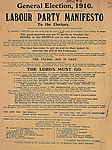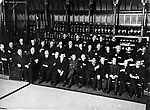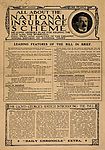 James Keir Hardie, founder of the Labour Party
James Keir Hardie, founder of the Labour Party Response to the Osborne Judgement 1908
Response to the Osborne Judgement 1908 Labour Party Manifesto 1910
Labour Party Manifesto 1910 Labour Party in Parliament 1911
Labour Party in Parliament 1911 National Insurance Scheme 1911
National Insurance Scheme 1911

The rise of the Labour party stemmed from the harsh working and living conditions of late 19th century Britain. In 1884 intellectuals formed the Social Democratic Federation, the Socialist League and the Fabian Society. The workers themselves formed trade unions, not only the old exclusive craft unions, but also new inclusive unions formed in the 1880s and composed of semi- skilled and unskilled workers. The success of the Match Girl’s Strike in 1887 and the Dock Strike of 1889 heralded the growth of mass unionism. By 1900 there were 2 million union members.
For some time Keir Hardie, one of Britain's most notable politicians and the first labour leader, had believed that various trade unions and the different socialist groups should join forces and form one large political party. Negotiations began in 1899 and in the following year the Labour Representation Committee was formed. Its aim was to return working class representatives to Westminster. The organisation developed into the Labour Party in 1906.
At first the LRC received only tepid support from trade unionists and the TUC. Then in 1901, came the House of Lords decision upholding the Taff Vale Judgement, which ruled that trade unions could be sued and compelled to pay for damages inflicted by its officials.
It now became clear that if the right to strike was to be preserved as an essential instrument of trade union policy, then the new principle embodied in the Taff Vale decision must be reversed in Parliament. If this was to be done then trade unions needed to secure greater and more influential representation in Parliament. A working arrangement was established with LRC and later Labour politicians, for joint, or complementary endorsements of Parliamentary candidates.
The Labour Party prospered during these pre-war years, a period in which trade union membership doubled. Its influence in Parliament, however, was dangerously dependent on the electoral pact engineered with the Liberals, who needed Labour’s votes in the Commons. There were a number of issues in Liberal policy with which the Labour Parliamentary Party agreed, but it recognised that in order to be more effective and independent it was necessary to break the alliance and build its own parliamentary strength. Better organisation in the constituencies was needed, and was achieved by persuading union branches and Trade Councils to allow Local Labour Parties to be formed.
There were a number of ways in which the Parliamentary Party was able to influence legislation and serve the interests of the unions and working people in general. The Trade Disputes Bill restored to trade unions the degree of legal immunity, which had been theirs before the Taff Vale Judgement. In 1908, the Mines Regulation Act limited the hours of underground work to eight. In 1909, the Trades Board Bill established trade boards with powers to fix minimum wages in certain notorious sweated industries. The women chainmakers of Cradley Heath were the first to benefit from this legislation. The Labour Party also played a part in pushing the Liberals towards the establishment of labour exchanges, unemployment insurance and old age pensions. From the time of the Tonypandy miners' riots in 1910 onwards, Keir Hardie pursued a personal campaign against police and military violence during strikes. It was the Labour Party that handled the miners’ case during the passage of the Coal Miners’ Minimum Wage Act, and did what they could to help unions in the London Dock Strike of 1912. A major success came in 1911 when, for the first time, MPs were paid a salary of £400 a year, making it easier for working men to stand for election.
The Trade Union Act of 1913 offered union members the opportunity to give their verdict on the Party’s record. The Act reversed the Osborne Judgement of 1908, which had ruled that it was unlawful for trade unions to contribute to political funds. Undoubtedly the overwhelming vote in favour of establishing a political fund was a vote for continued support for the Labour Party.
The war saw a real breakthrough for Labour. Trade union membership increased by over 50%, and a real increase in the party’s income followed. It rose fourfold from £11,322 to £48,776. The need to maximise production led to important improvements in working conditions. Also ‘war socialism’ favoured Labour’s philosophy of managing the economy; war was far too important to be left to the operation of free market forces. Labour even gained experience of government for the first time; the party entered the coalition formed in 1915, and two Labour men, including Arthur Henderson, who had succeeded Ramsay Macdonald as party leader, gained cabinet experience.
In 1918, franchise reform extended the vote to all men aged 21 and over, and to women aged thirty and over, who also owned property. Labour could now appeal to a mass electorate. In the General Election of that year the Labour Party brought 363 candidates to the poll. 140 of these were sponsored by local Labour Parties, 50 by the Independent Labour Party, 4 by the British Socialist Party and 163 were sponsored by individual Trade Unions. The largest group amongst trade union candidates were miners, accounting for 51 of the candidates.
The Labour Party won 57 seats at the 1918 election. No less than 50 of these were trade union sponsored. The Black Country returned four Labour MPs, including Charles Sitch of Cradley Heath, sponsored by the Chainmakers’ and Strikers’ Association, who at the time was secretary of the National Federation of Women Workers.
By this time, the Labour Party had emerged as the undisputed political voice of organised labour. The first Labour Government was elected in 1924, but lasted only nine months. Its progress continued to be rapid, however, and in 1929 Macdonald formed a second administration. Unfortunately its collapse followed in 1931, when the cabinet was unable to agree on the level of expenditure cuts needed in the face of financial crisis.
Rollover the captions in the box to see the available images in thumbnail format, click the caption to see the full-size image
| Reference: | 754 |
| Keywords: | |
| Archive Ref: | |
| Updated: | Wed 23 Apr 2008 - 1 |
| Interpretation written by | Barbara Harris |
| Author's organisation | |
| Organisation's website |